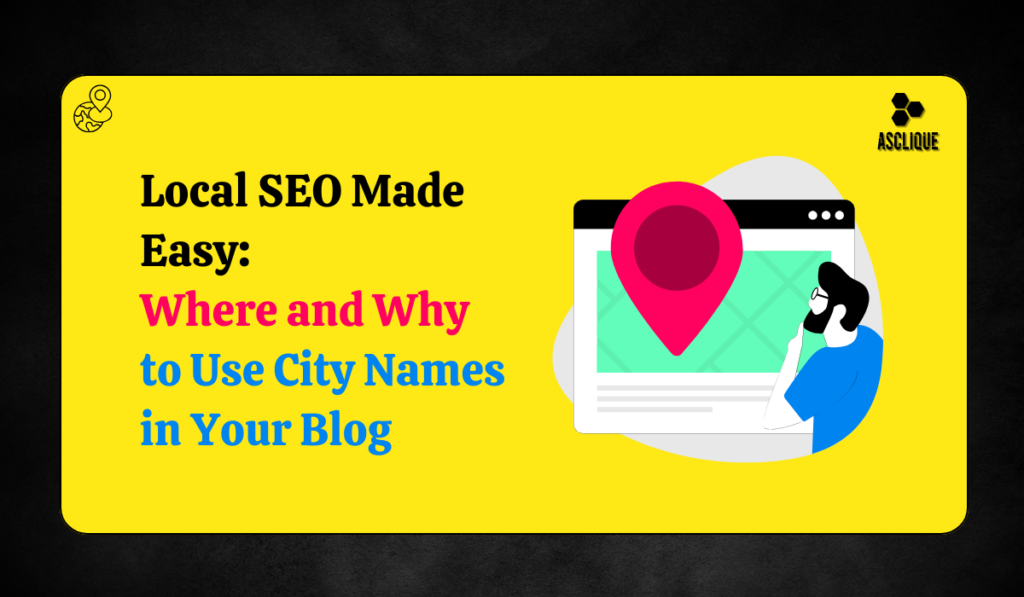Including city names in your blog is crucial for local SEO. It helps your content reach the right audience.
But where should you place these city names? Understanding where to include city names can boost your local search visibility. Local SEO isn’t just about adding a city name anywhere in your blog. It’s about strategically placing it where it counts.
This helps search engines connect your content with local search queries. In this post, we will explore the best spots to include city names. This will ensure your blog reaches people in your target area. By the end, you’ll know exactly how to optimize your blog for local searches. Let’s dive in and make your blog more visible to local readers!
Importance Of City Names In Local Seo
The importance of city names in local SEO cannot be overstated. Including city names in your blog helps search engines understand your content. This boosts your chances of appearing in local searches. Readers also benefit. They find relevant information quickly. This enhances their experience on your site.
Boosting Local Visibility
Using city names in your blog titles boosts local visibility. Search engines rank your content higher in local searches. Local customers find your business faster. This increases your chances of attracting new visitors. City names in headings and subheadings also help. This gives search engines context about your location.
Enhancing User Experience
City names improve user experience on your blog. Readers can easily identify content relevant to their area. This makes your blog more helpful to local users. Including city names in your content also builds trust. It shows you understand and cater to local needs. This encourages readers to spend more time on your site.
Strategic Placement Of City Names
Strategic placement of city names can boost your local SEO efforts. Including city names in key places helps search engines understand your content better. This approach can drive more local traffic to your blog. Here are two critical areas for placing city names: title tags and meta descriptions.
Title Tags
Title tags play a crucial role in SEO. They are the first thing users see in search results. Including city names in title tags can increase your blog’s visibility. For example, “Best Pizza Places in New York City” is more effective than “Best Pizza Places”. Make sure your city name is prominent. This helps search engines and users know your content’s relevance.
Meta Descriptions
Meta descriptions provide a brief summary of your blog. They appear below the title tag in search results. Including city names here can attract more local users. For instance, “Discover the top pizza places in New York City.” This approach enhances your blog’s local relevance. It also improves click-through rates from search results.
City Names In Content
Including city names in your blog content is crucial for local SEO. It helps search engines understand your target area. This boosts your visibility in local search results.
Introduction
Local SEO is essential for businesses targeting specific areas. Using city names correctly can improve your local search rankings. It helps search engines connect your content with local users.
Body Paragraphs
Integrate city names naturally in your content. Mention the city in your opening paragraph. This sets the context for the readers and search engines. Use the city name in headings where relevant.
Include the city name in the body text. Describe local events, landmarks, or community news. This makes your content more relevant to local readers. It also signals to search engines that your content is locally focused.
Use variations of the city name. Include neighborhood names or nearby towns. This broadens your reach within the local area. It also makes your content more relatable to a wider local audience.

Credit: www.asclique.com
City Names In Headings And Subheadings
Including city names in your blog headings and subheadings can boost your local SEO. This helps search engines identify your content’s relevance to a particular location. This section explains how to incorporate city names in various heading tags for optimal results.
H1 And H2 Tags
H1 and H2 tags are crucial for SEO. They tell search engines what your page is about. Including city names here can improve your local search ranking.
- H1 Tag: This is the main heading of your blog. Place the city name in the H1 tag for maximum impact.
- H2 Tags: Use H2 tags for subheadings. Add city names to these tags to reinforce local relevance.
Example:
Best Restaurants in New York
Top Italian Restaurants in New York
And H4 Tags
H3 and H4 tags provide additional structure and detail. They are useful for breaking down content into smaller, readable sections.
Including city names in these tags can further enhance local SEO by making the content more relevant to local searches.
- H3 Tags: Use H3 tags for smaller subheadings. Include the city name to maintain local relevance.
- H4 Tags: These tags are for even more detailed sections. Adding city names here helps with local SEO.
Example:
Best Pizza Places in New York
Affordable Pizza in New York
City Names In Urls
Including city names in URLs can significantly boost your local SEO efforts. It helps search engines understand your content’s relevance to specific geographic locations. This makes it easier for local users to find your services. Here’s how to effectively incorporate city names in your URLs.
Seo-friendly Urls
Creating SEO-friendly URLs is crucial for better search engine rankings. Include the city name in the URL to target local searches. Make sure the URL is concise and descriptive. Avoid unnecessary words and focus on the main keywords.
Here are some tips for creating SEO-friendly URLs with city names:
- Use hyphens to separate words.
- Keep the URL short and simple.
- Avoid using special characters.
Examples
To better understand the implementation, here are some examples:
| Service | City | SEO-Friendly URL |
|---|---|---|
| Plumbing Services | New York | www.example.com/plumbing-services-new-york |
| Web Design | Los Angeles | www.example.com/web-design-los-angeles |
| Car Repair | Chicago | www.example.com/car-repair-chicago |
These examples illustrate how to structure URLs for better local SEO. Including city names makes the URL more relevant to local searches.
City Names In Images
Including city names in images can boost your local SEO efforts. Images are a key part of any blog post. They make content more engaging and help with SEO. By adding city names to images, you can increase your visibility in local search results. It’s important to know where to place these city names for the best results.
Alt Text
Alt text is a description of an image for search engines. It helps them understand the image content. Adding city names to alt text can improve your local SEO. Describe the image and include the city name naturally. For example, “Sunset over the skyline in New York City.”
File Names
File names are also important for SEO. Search engines read these names. Include city names in your image file names. Use hyphens to separate words. For example, “new-york-city-skyline.jpg”. This helps search engines index your images correctly. It can boost your local search rankings.
City Names In Internal Links
Including city names in your internal links can boost your local SEO. It helps search engines understand the geographical relevance of your content. This practice can improve your site’s visibility in local search results.
Anchor Text
Use city names as anchor text in your internal links. This tells search engines that your content is relevant to that city. For example, if you write about restaurants in Miami, use “best Miami restaurants” as your anchor text.
Make sure the anchor text looks natural within your content. Readers should find the links useful and relevant. Avoid overstuffing keywords, as it can harm your SEO efforts.
Link Structure
Structure your internal links to include city names. For example, link to a page using a URL that contains the city name. This can be yourwebsite.com/miami-restaurants.
Use descriptive and clear URLs. They help both users and search engines understand your content. A well-structured link improves user experience and SEO.
Keep internal links organized and consistent. This helps search engines crawl your site more effectively. It also enhances user navigation, making it easier to find related content.
City Names In External Links
Including city names in external links is a smart strategy for local SEO. It helps search engines understand your blog’s geographic relevance. This makes your content more visible to local audiences. Below, we explore how to use city names in external links through backlinks and guest posts.
Backlinks
Backlinks are links from other websites to your blog. They are crucial for SEO. To boost local SEO, ensure these links include your target city name. For example, if you run a bakery in Boston, aim for links like “best bakery in Boston.”
Here’s a table that shows different types of backlinks and their impact:
| Type of Backlink | Impact |
|---|---|
| Anchor Text with City Name | High |
| Anchor Text without City Name | Medium |
| Generic Anchor Text | Low |
Use anchor texts that naturally fit the sentence. Avoid stuffing keywords. This keeps the content reader-friendly and effective.
Guest Posts
Guest posting involves writing articles for other blogs. Use this to include city names in your links. For instance, a guest post about local events can link back to your blog with the anchor text “events in Boston.”
Here are some tips for successful guest posts:
- Choose blogs with a local audience.
- Write engaging, relevant content.
- Include the city name naturally in the anchor text.
Guest posts can drive more local traffic to your site. They also build your reputation in the community.
Monitoring And Adjusting City Name Usage
Monitoring and adjusting city name usage is crucial for successful local SEO. This process involves tracking how city names are used in your blog posts. It helps you ensure they are driving the desired traffic and engagement. Regular monitoring allows you to make necessary changes to optimize your content. Let’s explore some useful tools and techniques for this purpose.
Analytics Tools
Utilize analytics tools to monitor your city’s name usage. Google Analytics is a popular choice. It provides detailed insights into how your content is performing. You can track which blog posts are getting the most traffic. See where your visitors are coming from. This data helps you understand the effectiveness of your city name usage.
Another tool to consider is SEMrush. It offers in-depth reports on keyword performance. You can see how well your city names rank in search results. This information is valuable for making adjustments. It helps you identify which city names are driving the most traffic.
Performance Tracking
Regular performance tracking is essential. It allows you to see if your efforts are paying off. Set up key performance indicators (KPIs) related to city name usage. Track metrics like organic traffic, bounce rate, and average session duration. These metrics give you a clear picture of your content’s performance.
Use tools like Google Search Console for performance tracking. It shows how often your blog appears in search results. You can see which queries are driving traffic to your site. Make adjustments based on this data to improve your local SEO.

Credit: www.linkedin.com

Credit: www.facebook.com
Frequently Asked Questions
How To Optimize Blog Posts For Local Seo?
Include city names in titles, headers, and content. This helps search engines understand your local relevance. Mention local landmarks and events. Use schema markup for local businesses. Ensure your blog is mobile-friendly and fast. Encourage local backlinks and citations.
Where To Place City Names In Blog Titles?
Place city names at the beginning of your blog titles. This makes it clear to both readers and search engines. For example, “New York Coffee Shops: Best Spots to Visit. ” This strategy improves local search visibility.
Should City Names Be In Blog Headers?
Yes, including city names in blog headers boosts local SEO. Headers organize your content and signal relevance to search engines. Use them naturally to describe sections about local topics. For example, “Top Restaurants in Los Angeles” as an H2 header.
Can City Names Be Used In Meta Descriptions?
Absolutely, using city names in meta descriptions enhances local SEO. Meta descriptions help search engines and users understand your content’s relevance. For example, “Discover top San Francisco attractions and events. ” This can increase click-through rates from local searches.
Conclusion
Including city names strategically boosts local SEO. Place them in titles, headers, and meta descriptions. Mention city names naturally within the content. Always keep readability in mind. Balance SEO practices with user experience. Engaging content helps local readers connect. Effective local SEO can drive more traffic to your blog.
Remember, consistency is key. Keep refining your strategies for better results. Happy blogging!




